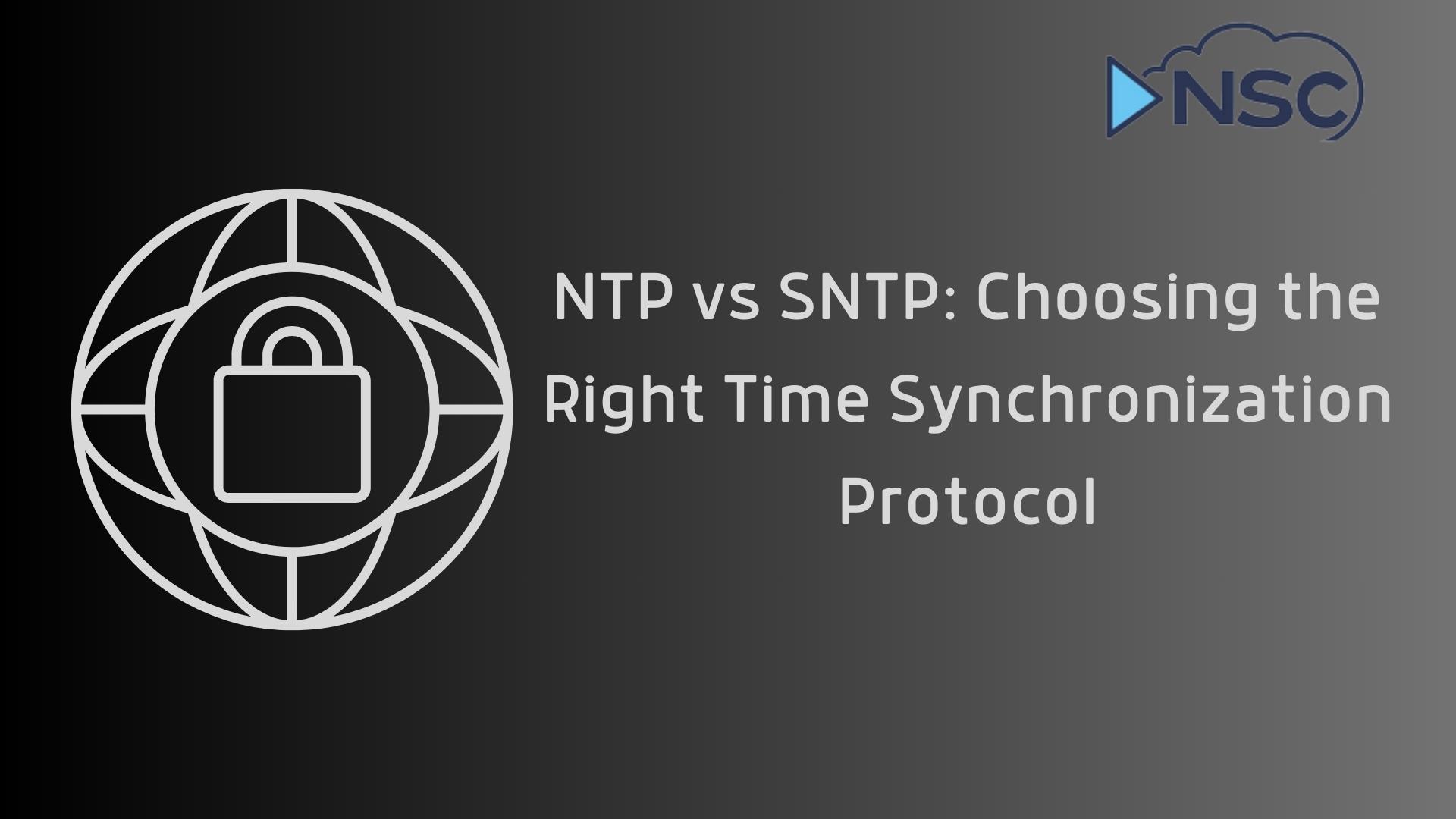In the intricate world of network management, accurate time synchronization isn't just a convenience—it's a necessity. Whether it's for ensuring that transaction logs are consistent or that security protocols are effective, the precision of network timekeeping can significantly impact the functionality and security of a network.
Among the protocols designed for this purpose, the Network Time Protocol (NTP) and the Simple Network Time Protocol (SNTP) are prominent players. While they serve similar functions, the choice between them can affect both the performance and the reliability of your network's time synchronization capabilities.
In this post, we delve into the technical nuances and practical implications of using NTP versus SNTP. We’ll explore their key features, configurations, andv best use cases to help you decide which protocol aligns best with your network requirements.
Understanding NTP
What is NTP?
The Network Time Protocol (NTP) is an essential protocol used for clock synchronization between computer systems over packet-switched, variable-latency data networks. Originally designed in 1985, NTP is one of the oldest Internet protocols still in use today. Its primary role is to synchronize the clocks of computers to within a few milliseconds of Coordinated Universal Time (UTC).
Key Features of NTP
- Robust Time Synchronization: NTP can synchronize time with a precision of milliseconds across the internet and even better in local networks.
- Network Configuration Flexibility: Supports various configurations, including NTP peer (where two or more servers synchronize with each other) and NTP master (a designated time server provides time updates to other machines).
- Scalability and Accuracy: Offers mechanisms to adjust the clock frequency and mitigate the effects of variable network delays, ensuring high accuracy and stability even as network conditions change.
NTP Version Differences
- Version 3 vs. Version 4: NTPv4 is an enhancement over NTPv3, supporting IPv6 and an increased range of timestamps for extended periods of synchronization. It also offers improved algorithms for clock selection and mitigation strategies against various types of errors and attacks.
Clock Updates and Synchronization
- NTP uses a hierarchical, semi-layered system of clock sources. At the top of the hierarchy are stratum 1 time servers, which are directly linked to an authoritative time source such as a radio clock or an atomic clock. Lower stratum levels serve time obtained from stratum 1 servers, providing redundancy and larger scale time distribution.
- NTP Peer vs. Server: In an NTP peer arrangement, servers operate on a symmetrical basis, ideally suited for systems where each node is capable of both providing and consuming time data. Conversely, in an NTP master configuration, one server acts as the sole time provider, simplifying the network but potentially creating single points of failure.
This detailed look at NTP demonstrates why it is widely used in environments that require precise timekeeping and robust network configurations. With its capacity for high accuracy and flexibility, NTP serves as a critical component in many network infrastructures.
For those looking to deepen their understanding of network time protocols, particularly in professional settings, our Self-Paced Cisco Certified DevNet Associate Course offers comprehensive insights into configuring and managing network technologies, including advanced time synchronization.
Understanding SNTP
What is SNTP?
The Simple Network Time Protocol (SNTP), as its name suggests, is a simplified version of the Network Time Protocol. It is designed for systems where the high precision and complexity of NTP are not required. SNTP can be used when the ultimate accuracy of a few milliseconds is not necessary, making it suitable for smaller networks or devices with less critical timing needs.
Key Features of SNTP
- Simplicity and Ease of Configuration: SNTP's major advantage is its simplicity. It lacks some of the complex features of NTP, making it easier to implement and manage, particularly in environments without large scale time-sensitive operations.
- Lower Resource Requirements: Due to its simplified approach, SNTP requires fewer resources on the network and the devices it runs on, which is beneficial for smaller or less capable hardware.
Limitations Compared to NTP
- Reduced Accuracy and Stability: While SNTP is adequate for many applications, it does not provide the same level of accuracy or stability as NTP. This is because SNTP does not implement complex algorithms for time correction that account for network delay variations.
- No Complex Time Synchronization Features: SNTP does not support features like clock filtering, frequency discipline, or the peer-to-peer mode that are standard in NTP. This makes it less adaptable to changing network conditions or higher demands on time precision.
Practical Suitability
SNTP is often employed in consumer electronics and other non-professional settings where the exact time is not critical but a reasonable accuracy is still required. It is also used in scenarios where network devices need to have a general sense of current time without the stringent requirements imposed by professional-grade time synchronization.
This segment outlines the fundamental aspects of SNTP and why it may be chosen over NTP in certain less demanding environments. Its simplicity and lower resource needs make it a compelling choice for specific contexts, despite its limitations in accuracy and functionality compared to NTP.
For those implementing SNTP in less critical environments or seeking to understand its practical applications further, our course on Scapi for Network Automation can provide valuable insights. This course not only covers basic network protocols like SNTP but also delves into automating network configurations efficiently.

Comparison of NTP and SNTP
Accuracy and Network Load
- NTP: Offers exceptional accuracy, typically within a few milliseconds on wide area networks, and even better on local area networks. NTP's sophisticated algorithms adjust for delay variance and network jitters, making it ideal for applications where precise timing is crucial.
- SNTP: While SNTP provides satisfactory accuracy for many applications, it generally achieves less precision than NTP, usually within tens of milliseconds. Due to its simpler implementation, it places less load on the network, which can be an advantage in less demanding environments.
Configuration Complexity
- NTP: NTP's configuration can be complex due to its numerous options for customization and optimization. Configuring NTP often involves setting up multiple servers and clients with carefully considered strata to ensure redundancy and reliability. Examples include specific ntp configuration commands like ntp peer, ntp master, and ntp server cisco.
- SNTP: SNTP's simplicity means it can be configured quickly and with minimal technical knowledge. This simplicity is particularly advantageous in small networks or in applications where time synchronization is not mission-critical but still needed.
Suitability for Different Network Sizes and Types
- NTP: Best suited for medium to large networks where time accuracy can significantly impact system performance and operational integrity. NTP is also preferable in networks where security and accuracy are paramount, such as in financial transactions or operations that depend on precise time logging.
- SNTP: Ideal for smaller networks or devices where slight variations in time synchronization do not cause significant disruptions. SNTP is often used in home networks, small business environments, and on consumer-grade electronics like network cameras and residential gateways.
In this detailed comparison, it becomes evident that the choice between NTP and SNTP should be guided by the specific needs and scale of the network, as well as the critical nature of the tasks that depend on accurate time synchronization. Each protocol offers unique advantages that can be matched to the requirements of different environments.
|
Feature |
NTP |
SNTP |
|
Accuracy |
Milliseconds precision across WAN, better on LAN |
Tens of milliseconds, generally less precise |
|
Network Load |
Higher due to complex synchronization algorithms |
Lower, due to simpler synchronization process |
|
Configuration Complexity |
Complex, with multiple options for optimization |
Simple, minimal configuration required |
|
Suitability for Network Size |
Ideal for medium to large networks |
Best suited for small networks or non-critical applications |
|
Resource Requirements |
Higher, requires more capable hardware for full functionality |
Lower, can run on less capable hardware |
|
Features |
Supports clock filtering, frequency discipline, peer-to-peer mode |
Lacks complex time correction and peer modes |
Common Issues and Troubleshooting
Common NTP Issues
NTP can occasionally face synchronization problems, such as drifts or the loss of connection with time servers. These issues might result from network congestion, improper configuration, or problems with the time source itself.
- Commands and Solutions:
- show ntp associations: This command is essential for diagnosing issues, as it displays the status of NTP peers, helping identify any servers that are not properly synchronizing.
- ntp clock-period: Adjusting the clock period can help in compensating for drift and improving synchronization accuracy.
Security settings can also pose challenges, particularly in securing time data against spoofing and man-in-the-middle attacks.
- ntp allow mode control: This command should be used cautiously as it allows more extensive control over the NTP server, potentially opening up avenues for misuse.
Common SNTP Issues
SNTP tends to be less problematic due to its simplicity, but it still can encounter issues primarily related to network delays affecting time accuracy.
- Simplified Troubleshooting:
- Due to SNTP's straightforward nature, troubleshooting usually involves basic network checks and ensuring the SNTP server addresses are correctly configured and accessible.
In both protocols, ensuring proper initial configuration and regular monitoring can significantly reduce the incidence of issues. For networks where time synchronization is a critical component, employing redundancy in time servers and diversifying server sources can also enhance stability and reliability.
Summary
Choosing between NTP and SNTP depends largely on the specific requirements of your network environment. NTP, with its high precision and robust features, is ideal for large-scale and critical infrastructures where exact timing is crucial for operations and security. On the other hand, SNTP offers a simpler and resource-efficient solution perfect for smaller networks or applications where precision is less critical.
- NTP should be the choice for environments that require meticulous time synchronization to support complex network operations and ensure compliance with strict regulatory standards.
- SNTP is suitable for casual or less critical uses where simplicity and minimal network load are more beneficial than millisecond accuracy.
In summary, the decision to use NTP or SNTP should align with your network's scale, complexity, and specific time synchronization needs. Understanding the strengths and limitations of each protocol will enable you to optimize your network's performance and reliability effectively.


